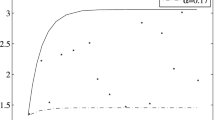Abstract
When modelling any system using ordinary differential equations, the problem arises of gauging the sensitivity of state predictions to arbitrary functional perturbations to the right-hand sides of the chosen differential equations. Assuming that a suitable Riemannian measure of the distance or gap between any two states (as possible predictions) has been chosen, a scalar functionr(·) of the state is defined which characterizes the insensitivity of a nominal prediction to finite functional perturbations in the differential equations. The limiting behaviour ofr(·) near the nominal prediction defines a second rank symmetric positive definite tensorM, which provides an easily computed and convenient description of the insensitivity of the nominal predictionin each direction to ‘infinitesimal’ functional perturbations in the model. This theory is fully invariant under arbitrary smooth transformations of state variables.
Similar content being viewed by others
References
I. Ben-Arroyo, and D. H. Martin, SENS—A package of FORTRAN subroutines for functional sensitivity analysis of systems of ordinary differential equations,NRIMS Special Report SWISK 8, Pretoria, January 1979.
G. A. Bliss,Lectures on the Calculus of Variations, University of Chicago Press, Chicago, 1946.
J. B. Cruz,System Sensitivity Analysis, Dowden, Hutchinson & Ross, Stroudsberg, Pennsylvania, 1973.
D. C. J. de Jongh, and P. J. Vermeulen, Structure and Prediction in ‘The Limits to Growth’,Proceedings of the International Conference on Cybernetics and Society, 1976, IEEE, Inc., New York, New York, 135–142, 1976.
D. C. J. de Jongh, Structural parameter sensitivity of the ‘Limits to Growth’ world model,Applied Mathematical Modelling,2, 77–80, 1977.
P. M. Frank,Introduction to System Sensitivity Theory, Academic Press, New York, New York, 1978.
N. S. Goel, S. C. Maitra, and E. W. Montroll, On the Volterra and other nonlinear models of interacting populations,Reviews of Modern Physics,43 (2), 231–276, 1971.
I. Gumowski, Sensitivity with respect to functional variations,Preprints of Second IFAC Symposium on System Sensitivity and Adaptivity, Dubrovnik, B.1–B.7, 1968.
S. T. Hu,Differentiable Manifolds, Holt, Rinehard and Winston, Inc., New York, New York, 1969.
D. Lovelock, and H. Rund,Tensors, Differential Forms, and Variational Principles, John Wiley & Sons, New York, New York, 1975.
D. H. Martin, Functional sensitivity for ordinary differential equations,NRIMS Technical Report TWISK 65, Pretoria, January 1979.
J. Milnor,Morse Theory, Annals of Mathematics Studies #51, Princeton University Press, Princeton, New Jersey, 1963.
E. C. Pielou,An Introduction to Mathematical Ecology, John Wiley & Sons, New York, New York, 1969.
H. Rund,The Hamilton-Jacobi Theory in the Calculus of Variations, D. van Nostrand Company, London, 1966.
R. Tomavic, and M. Vukobratovic,General Sensitivity Theory, Elsevier, New York, New York, 1972.
Author information
Authors and Affiliations
Additional information
Communicated by S. K. Mitter
Rights and permissions
About this article
Cite this article
Martin, D.H. Prediction sensitivity to functional perturbations in modelling with ordinary differential equations. Appl Math Optim 6, 123–137 (1980). https://doi.org/10.1007/BF01442888
Received:
Issue Date:
DOI: https://doi.org/10.1007/BF01442888




